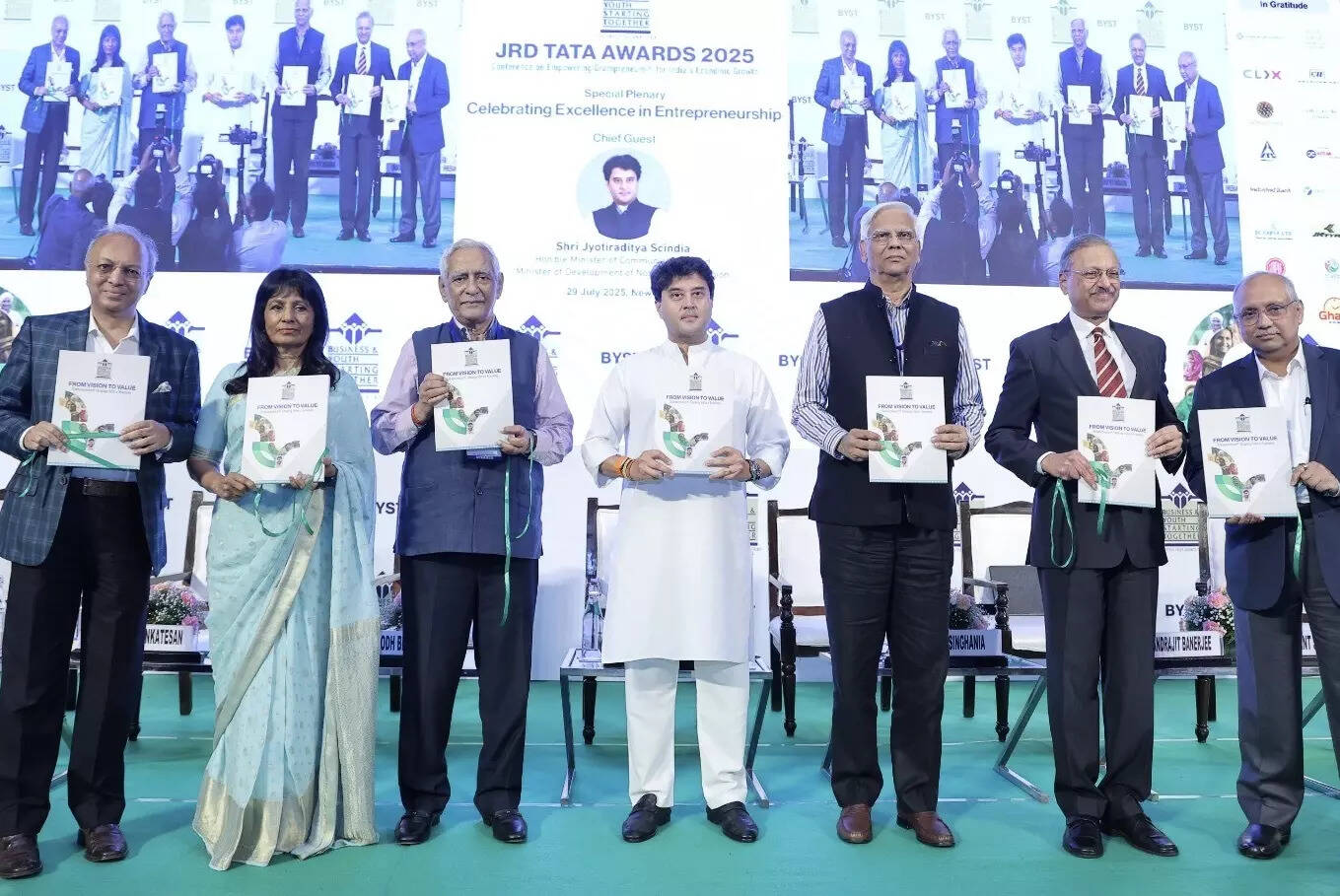
In an era obsessed with unicorns and startup valuations, it is easy to overlook the quiet revolution brewing in India’s hinterland.
The 2025 edition of the JRD Tata Awards, organised by the Bharatiya Yuva Shakti Trust (BYST) on July 29, turned the spotlight toward a different kind of innovator — the Grampreneur.
These are micro-entrepreneurs from rural and semi-urban India who, with modest resources and immense resolve, are redefining what it means to build from the grassroots.
At the heart of this movement is Lakshmi V. Venkatesan, Founding and Managing Trustee of BYST, who left behind a career in science and corporate world to mentor a generation of young Indians into self-made job creators.
In this conversation with ETGovernment’s Anoop Verma, she speaks about the ethos behind the awards, the genesis of the Grampreneur concept, the transformative power of mentorship, and why micro-entrepreneurs must be recognised not as footnotes to economic policy — but as its driving force. What emerges is a portrait of inclusive capitalism, anchored not in theory, but in lived impact.
Edited excerpts:
What is the core focus of the JRD Tata Awards 2025 and what do you hope to achieve through this initiative?
Entrepreneurs are celebrated all the time. But how often do we hear of Grampreneurs—micro entrepreneurs from rural or semi-urban India—being honoured? Perhaps they get a footnote in the MSME awards, lumped together with small and medium enterprises. But that misses the point. Micro enterprises—those run by Grampreneurs—make up 98% of all MSMEs in India today. They are the backbone of employment in small towns and rural areas. If we don’t learn how to recognise, support, and elevate these entrepreneurs, we aren’t even close to solving the core challenges of economic inclusion.
The JRD Tata Awards focus squarely on celebrating these Grampreneurs with the same lens we use for medium or large businesses. We assess their growth trajectory, employment generation, innovation, contribution to society, and even exports. The jury, led by Dr. Anantha Nageswaran, Chief Economic Advisor to the Government of India, found it nearly impossible to choose—there were so many outstanding candidates. That speaks volumes.
And why name it after JRD Tata?
Because he believed deeply in the latent potential of young people from small towns and rural India. He wasn’t content with just seeing them survive on subsidies or survive as self-employed individuals. He believed that, with the right support—financial, yes, but more importantly mentorship—they could become real job creators and innovators. That spirit guides this award.
Identifying such entrepreneurs must be incredibly challenging, given how many micro-entrepreneurs are out there. What is your selection process like?

You’re right—it would be impossible to scout every micro-entrepreneur across India. That’s why the JRD Tata Awards are drawn from within the pool of entrepreneurs supported by BYST (Bharatiya Yuva Shakti Trust).
These are individuals we’ve mentored and financed from the ground up. From day one, we instill a mindset of professionalism. Whether someone receives ₹50,000 or ₹15 lakh, they are expected to keep books, integrate with the banking system, pay taxes if applicable, adopt digital tools, and pursue sustainable practices. It’s about shaping a mindset, not just doling out money.
These entrepreneurs aren’t simply making pickles or papads—though those are respectable ventures too. They are people innovating in solar technology, water-efficient farming through plastic mulching, millet-based chocolates, and even sanitisation tools that moved from rural markets to urban use during the pandemic. One of our awardees, at the JRD Tata Awards, Yogesh Kande, was recently recognised by Bill Gates for his frugal innovation in pesticide sprayers. It’s this spirit of frugal, context-aware innovation that we cultivate and celebrate.
You made a significant transition from a corporate and scientific background to social entrepreneurship. What motivated that change?
Yes, I was at Bell Labs in the U.S., working as a systems engineer and research scientist—a rare path for a woman at the time. I was one of only five women among 500 men in the telecom planning division. One of my early responsibilities was mentoring young women engineers, many of whom were from minority communities. That’s where I first understood the power of mentorship—not just as guidance, but as a transformational force.
In 1990, I accompanied my father on a state visit to the UK—he was President of India at the time—and during lunch at Buckingham Palace, I had a conversation with the Prince of Wales about The Prince’s Trust. It focused on exactly this: mentoring and supporting youth entrepreneurship. That conversation stayed with me.
When I returned to India, I reached out to JRD Tata. I told him I had no experience in India’s entrepreneurial ecosystem and asked for help. At the age of 86, he didn’t just offer advice—he became the founding Chairman of BYST. He believed mentoring was powerful because it had changed lives, even outside the formal business world. He had mentored two individuals who later came back to thank him for helping them build successful ventures. That reinforced his belief in mentorship, and it strengthened my own.
So yes, my journey from physics to philanthropy is unconventional, but it’s deeply rooted in the same principles of system thinking, problem-solving, and innovation—just applied to human potential.
The term “Grampreneur” is unique and evocative. How did it emerge, and how does it differ from traditional entrepreneurship models in India?
The term Grampreneur is deliberate—it blends the rural energy and social rootedness of the village (gram) with the risk-taking and innovative spirit of an entrepreneur. Too often we classify entrepreneurs into rigid silos: rural vs urban, self-employed vs unicorn, subsistence vs high-growth. But reality is more complex.
A Grampreneur doesn’t necessarily reside in a village. They could be based in Jaipur, Pune, or Chennai. What matters is how their value chain connects to rural India—through sourcing, selling, labour, or innovation. The term recognises that these entrepreneurs operate at the intersection of grassroots and growth.
They are not merely surviving; many are thriving. Their businesses are not charity cases—they are competitive, resilient, and increasingly tech-enabled. Some have scaled from ₹50,000 turnovers to ₹50 crore enterprises. And the ones who haven’t reached those heights still become local role models. In places like Raigarh, people no longer just ask companies for jobs. They ask for loans to start their own businesses. That’s the real mindset shift.
According to your reports, BYST has helped generate around 5 lakh jobs and a business value of ₹6,000 crore. How are these figures calculated? And how do you assess success beyond just numbers?
We conduct an annual data survey and remain deeply connected with our beneficiaries, going back to 1992. We track their current turnover and employment status. Job creation is at the very heart of our mission, especially for the educated youth who remain unemployed in large numbers across India.
So far, BYST’s direct financing has amounted to approximately ₹1,000 crore. Our evaluations show that many of our entrepreneurs achieve a turnover ten times their investment—sometimes even up to a thousandfold. So translating ₹1,000 crore of support into ₹6,000 crore in value is not only reasonable but entirely credible.
What makes our model distinct is the impact per entrepreneur. The average micro-enterprise in India employs just about 1.2 people—a statistic that has remained static for decades. But our entrepreneurs change that dynamic. They typically generate around ten direct jobs and another forty indirect jobs, thanks to the interconnected value chains involving suppliers, local services, and customers. These are not isolated micro-retail shops but active, networked enterprises.
The reason this works is because we embed mentorship at every level—whether with the entrepreneur, within the bank, or at the level of the district administration. That’s what enables sustainable and scalable impact.
Your Mentoring India program seems central—how did you build and sustain such a vast volunteer network, and what ensures mentor quality and commitment?
This is where BYST truly differentiates itself. When we began, we looked at the UK model where corporate professionals volunteered as mentors. But in India, we turned to local chambers of commerce, Rotary and Lions clubs—anywhere where grassroots business expertise already existed.
We also recognised early on that being a good businessperson doesn’t automatically make you a good mentor. So we created a ‘train-the-trainer’ model and introduced formal certifications—international ones from the City & Guilds of London and national ones from NIMSME. That gave mentors both credibility and pride.
Today, BYST hosts India’s largest mentor network—over 20,000 trained mentors. They meet regularly, both physically and virtually, participating in peer-learning sessions and upskilling webinars. Many of them have even trained international mentors across 70 countries through our collaboration with Youth Business International. It’s more than just an organisation now—it’s a movement. A movement powered by volunteers who are deeply committed and proud of their role.
You aim to scale further in the next five years—how realistic is that?
Our goals are ambitious, but they’re not speculative—they’re based on evidence. We plan to scale our mentor base from 20,000 to 200,000, support one million entrepreneurs, and create 50 million jobs. It might sound simplistic when stated like that, but the math adds up if you’ve truly understood what micro-entrepreneurs need and have the right ecosystem to support them. BYST has shown that creating 10,000 entrepreneurs is entirely doable for one organisation. Scaling it nationally just requires sustained focus, policy support, and committed partnerships.
How cooperative has the government been at various levels? Any reforms needed to support your model?
We engage closely with local governance structures—from panchayats to district collectors—and conduct outreach through business idea contests and mentoring camps. But to go to the next level, we need policy differentiation. Micro-enterprises must be treated separately from MSMEs. The needs are completely different, and clubbing them together masks that reality.
We also need rural-specific frameworks for ease of doing business—better digital infrastructure, more integrated mentoring with MUDRA loans, district-level financial literacy, and last-mile logistics like roads. These are not extravagant tasks. They are essential for real empowerment. In the US, mentoring is mandated for small business loans by Congress. Why not here?
You’ve supported about 50,000 entrepreneurs so far, about 30% of whom are women. How has scaling progressed?
We’ve supported around 50,000 entrepreneurs, and nearly 30% are women. In the early years, we were adding just about a thousand entrepreneurs annually. But after investing in the necessary skills, mindset development, and mentor infrastructure, we reached the point where we could support 10,000 entrepreneurs a year. The groundwork has been done. We are now at a tipping point for exponential growth.

